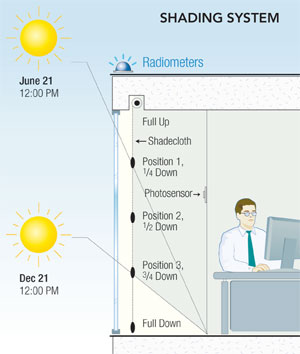Automated Shading and Light Systems
Today, building orientation and shallow floor plates are still used to maximize the daylighting levels in a building, while providing some protection against glare-causing direct sunlight. Good building orientation helps minimize the building's exposure to direct sunlight throughout the day, especially during sunrise and sunset, and shallow floor plates help to maximize the daylighting levels that are possible throughout the interior.
New innovations in permanent exterior and interior shading devices, like fixed overhangs and high-performance glazing, provide constant glare control, but are limited in their ability to offer any variety in the amount of daylight protection they provide. As a result of their static and unmoving nature, these systems may be vulnerable to direct sunlight penetration at certain times of the day or year, or, if designed for aggressive daylight management, they may minimize the amount of daylight allowed on the work floor altogether.
Internal shading or blinds systems that rely on daily manual manipulation are often pulled down on a bright day to block the harsh direct light streaming through the windows and then left down every day after that, negating the original design intent to provide a view to the outdoors and illuminate the interior with daylight.
Unfortunately, these traditional approaches to daylighting do not offer any dynamic, automated control of the daylit environment. The building envelope, complete with glazing and fixed overhangs, treats daylight on a cloudy day and daylight on a sunny day as if they had equal opportunity to create glare. It is the same structure every day, all year round, through summer sun, winter sun, and shadow. Manually controlled devices put the onus on individual occupants to manage the building's interaction with the sun, which almost always results in the daylight not being managed at all.
New Daylighting Tool—Automated Shading Systems
There is a new daylighting solution that equips buildings to actively monitor and respond to ever-changing daylight conditions. An automated shading system predicts, monitors, and responds to the unique microclimate of the building. For example, the system can determine if the day is sunny or cloudy, or if a zone of windows is in shadow and adjust the shade positions accordingly to maximize the amount of ambient daylight in the space.
Comprised of motorized solar shades, roof-mounted solar radiometers that monitor sky conditions in real time, exterior-mounted photometers that monitor sky brightness, interior-mounted photosensors that monitor each building façade for the presence of direct sunlight (local brightness), and advanced daylighting software, this system raises and lowers solar shades automatically in response to the position of the sun and the sky conditions detected by the sensors. In addition, the woven solar fabrics used as the physical shades enable building occupants to view the outdoors, even when the shade is deployed in the down position.
 |
Automated shading systems provide dynamic daylight control, automatically adjusting the position of the shades to best accommodate the position of the sun, regardless of the time of year. Image courtesy of MechoSystems |
Architects used to refer to historical weather data and sunpath diagrams to predict where the building was at risk for direct sunlight penetration, addressing the potential threat with a permanent shading solution. Now, automatic shading systems monitor and respond to the actual, daily microclimate of the building, offering a customized shading solution that changes whenever weather conditions, direct sunlight, or new season warrant. They also have the ability to recognize when skies are cloudy and compensate for undesirable sky brightness and shadow. This informed flexibility enables an automated shading system to maximize the amount of daylight that can penetrate the space and still protect the interior from direct sunlight, when present.
Actively manage direct sunlight. The automated shading system continuously monitors for the presence of direct sunlight and actively manages the access that direct sunlight has to the interior. The system constantly calculates the sun's angle on each window in the building. It takes into account window elevation, solar geometry, orientation, and profile angle. Structural elements such as balconies, overhangs, and fins that may block the sun are included in these calculations. The system then adjusts the shade position to manage the distance that any direct sunlight can enter a space.
Differentiate between clear and cloudy days. Specialized scientific solar radiometers are mounted on the roof and monitor real-time sky conditions, enabling the system to determine if it is clear or cloudy. When cloudy, the shades are raised, welcoming the pleasant and diffused daylight into the building. When clear, the shade position is adjusted according to the solar angle and any user-defined zone parameters to prevent glare-causing direct light from wreaking havoc in the visual environment.









